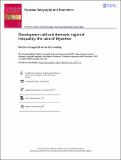Development aid and domestic regional inequality : the case of Myanmar
Abstract
There is a cyclical nature to the dilemmas confronting international donors willing to operate in Myanmar. Brief periods of relative openness have led to rapid surges in development assistance, regularly interrupted by long phases of military rule and similarly swift disengagement by donors. Amidst all this, the country’s many predicaments remain. This article engages with one of them: the inequality between regions, including that between the Bamar-majority centre and the periphery, mostly inhabited by ethnic minority groups. How have international donors reacted to the issue of domestic regional inequality? Although some recent scholarly studies show that official development assistance (ODA) does not target poor regions very well, it is not always clear why this is the case. Myanmar offers a particularly instructive case to seek an answer to this question. The country's sudden, yet uneven and unequal liberalisation from 2011 to 2021 catalysed huge inflows of ODA, while it also confronted donors with new policy dilemmas. The article shows that international donors struggle with the problem of rising regional inequality, especially for political reasons. Donor and recipient interests often do not align well on this issue. In the case of Myanmar, donors who press for regional inequality to sit prominently on the agenda might fare less successfully than those who address the issue indirectly. Going beyond Myanmar, the article concludes that regional inequality and, in particular, the politics of targeting deserve a more central role in the political economy of ODA.
Citation
Fumagalli , M & Kemmerling , A 2022 , ' Development aid and domestic regional inequality : the case of Myanmar ' , Eurasian Geography and Economics , vol. Latest Articles . https://doi.org/10.1080/15387216.2022.2134167
Publication
Eurasian Geography and Economics
Status
Peer reviewed
ISSN
1538-7216Type
Journal article
Description
Funding: The work was supported by the Arts and Humanities Research Council [AH/S00405X/1]; the Open Society Foundations; the Thyssen Foundation [Az. 50.14.0.046]; the Academy of Korean Studies [AKS-2015-R39]; and Universität Erfurt.Collections
Items in the St Andrews Research Repository are protected by copyright, with all rights reserved, unless otherwise indicated.

